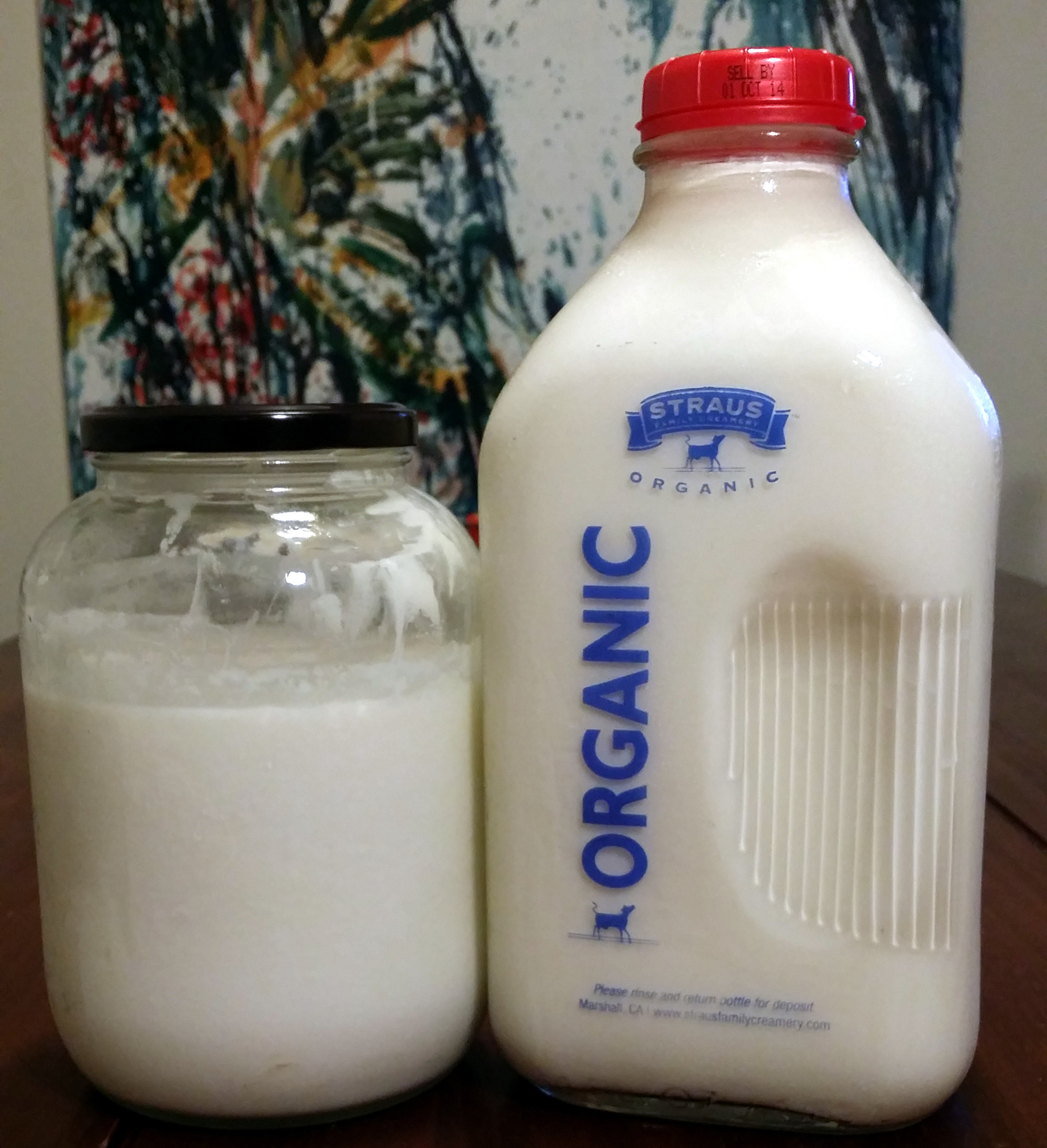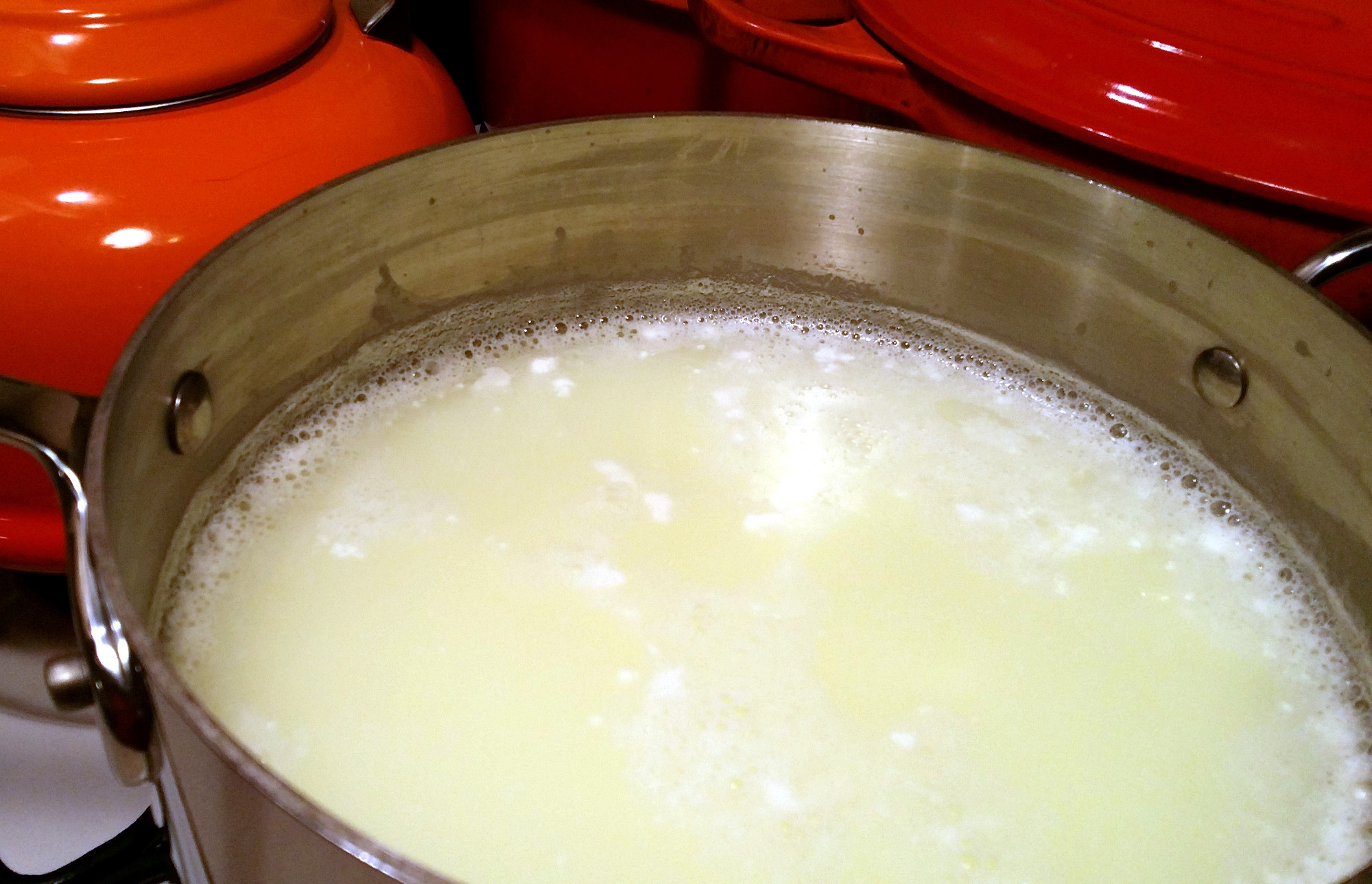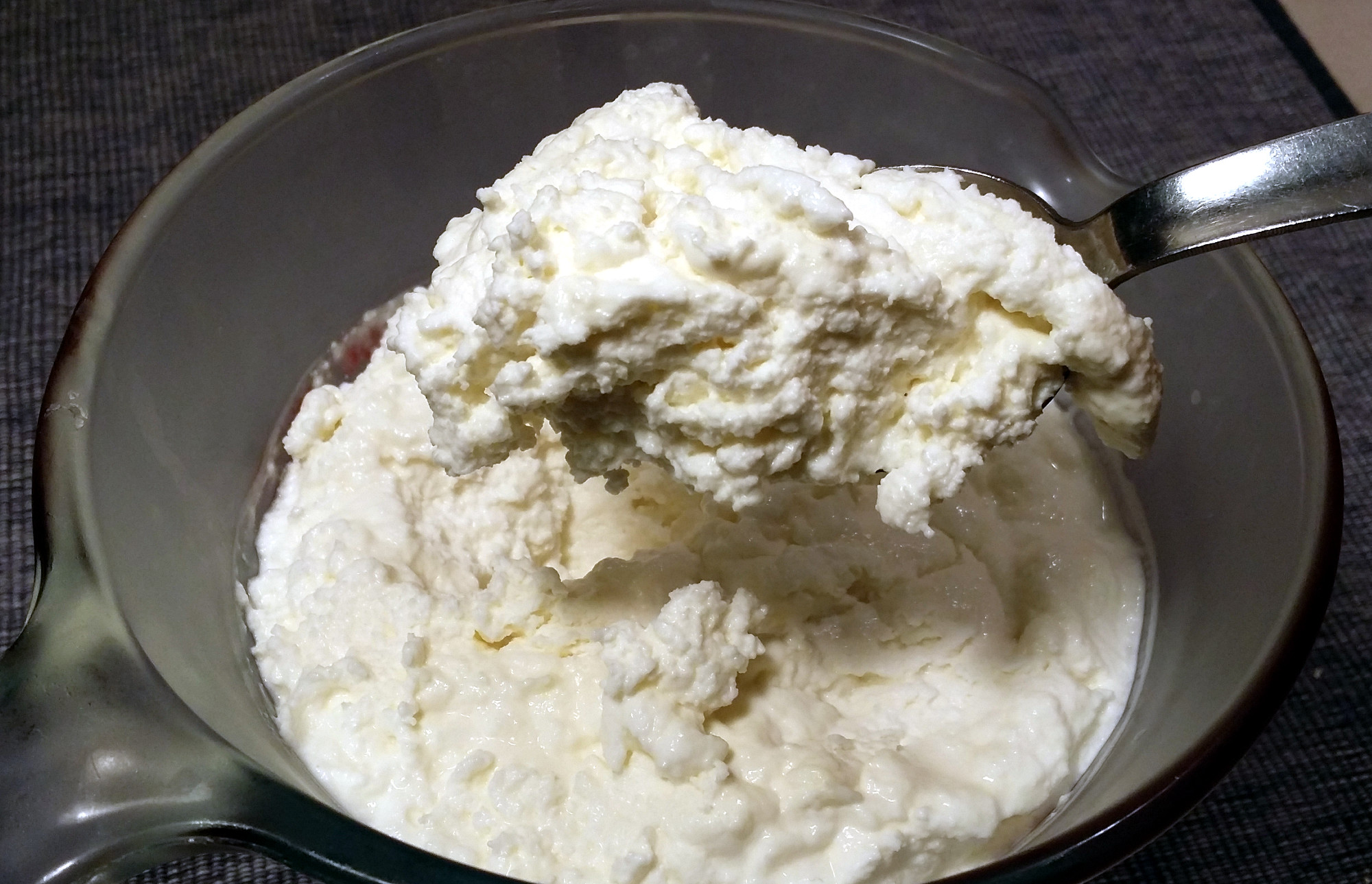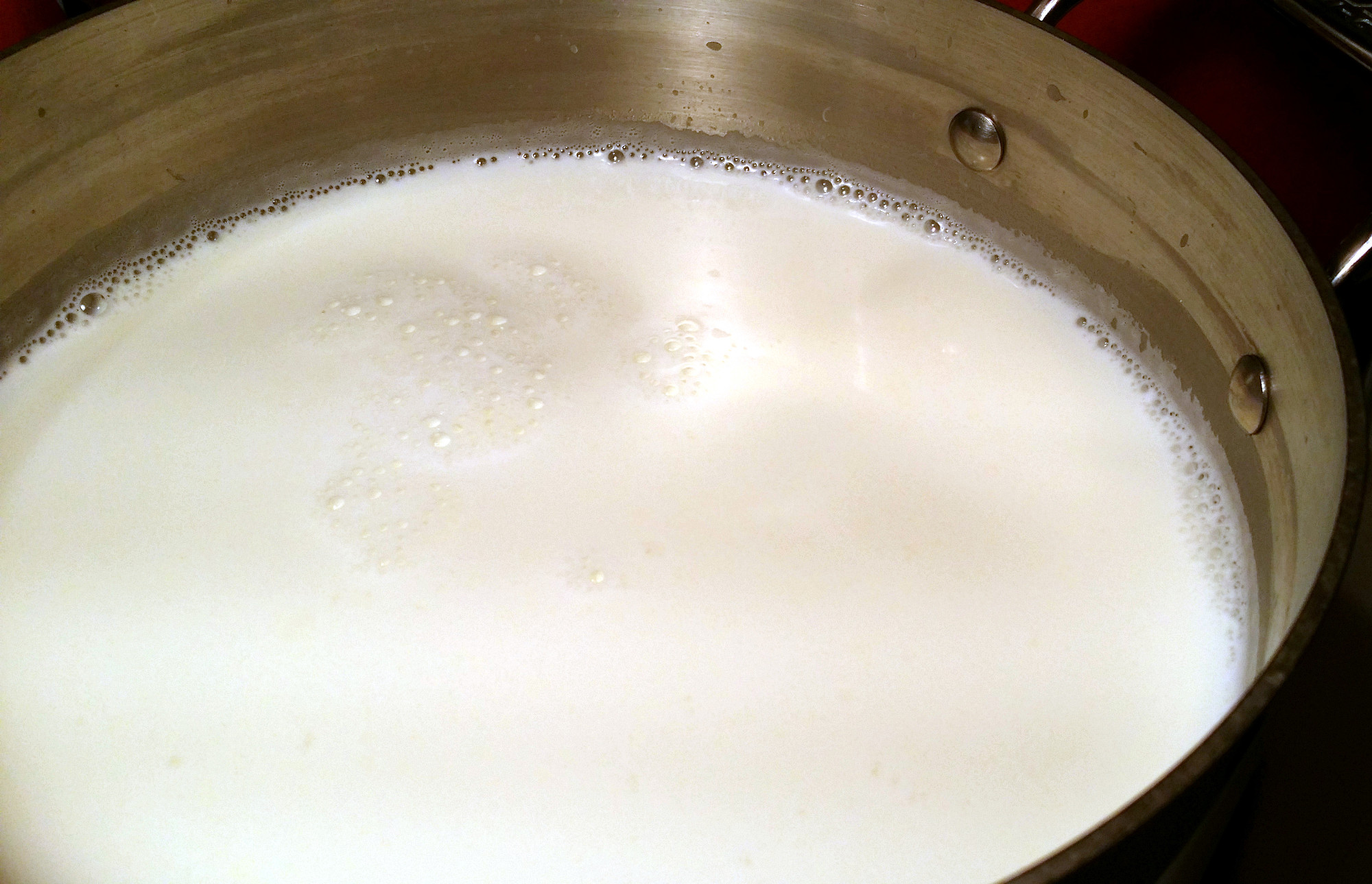Click here to go straight to the recipe.
You may never buy ricotta cheese again after you taste this. Dense, creamy and delicious homemade ricotta surpasses any store-bought brand I’ve ever tried, and requires only two ingredients and about twenty minutes of actual cooking time.
I use high quality ingredients to make ricotta—Straus organic milk and my homemade buttermilk (also made with Straus milk). I buy only whole milk. Fat tastes good and we need it. Do not use skim or non-fat milk as those lack the fat necessary to make ricotta.
Straus milk is pasteurized but not homogenized. For cheese-making, homogenized milk retains more moisture and fat in the curd and renders a finer, denser texture, according to food writer Harold McGee. (If you find the science of the kitchen as fascinating as I do, check out his classic On Food and Cooking.) Do not use ultra-pasteurized milk, as it may not curdle.
Many ricotta recipes call for lemon juice or vinegar rather than buttermilk. Because I only need milk to make my buttermilk (milk + a bit of cultured buttermilk = more cultured buttermilk), I buy fewer products and so prefer this method.
I avoid buying anything packaged in plastic, especially food. I don’t want to be exposed to BPA any more than I already am (the stuff is everywhere), but even more so, I want to contribute as little as possible to the mind-boggling problem of plastic pollution. Until I get that cow (one day…), I can’t get much closer to plastic-free and zero-waste than buying milk in returnable glass bottles.

Ingredients
Yields 2 cups
- 1/2 gallon (8 cups) whole milk
- 2 cups cultured buttermilk (not flavored buttermilk)
Directions
1. Combine milk and buttermilk in a pot. I used a 4-quart size.

2. Heat mixture slowly until it reaches between 190 to 200 degrees—the temperature it hits just before it boils. It will curdle at this point. Turn off the heat.
My instant-read thermometer broke when I last made yogurt (I dropped it in the pot of milk) but I had no problem determining when to turn off the flame for my ricotta. The milk did remain creamy and uniform for what seemed a long time and I thought curdles would never form. But they did. I don’t think I’ll bother replacing my thermometer.

3. Wait 20 minutes for the curds to sink to the bottom of the pot.
4. Over a bowl, place a sieve lined with a thin towel. Transfer the curdled milk to the sieve.

5. Let the ricotta strain for about half an hour, depending on how wet you want it. Transfer it to a glass container and store in the fridge for up to a week.

Ricotta cheese produces an alarmingly large amount of whey. Unfortunately, the heat kills the microbes in the buttermilk culture, so I can’t use this for any lacto-fermentations 🙁 But I will make pizza tomorrow with the ricotta as a topping and I’ll replace the water with whey in the dough. I’ll also make bread with some whey. I may have to freeze one of these jars though because I can bake only so much bread.
What should I make with the rest of this homemade cheese? Do you have a favorite recipe that calls for ricotta? I would love to hear about it.
Ricotta Cheese
Yields 2 cups
Ingredients
- 1 gallon (8 cups) whole milk
- 2 cups cultured buttermilk
Directions
1. Combine milk and buttermilk in a pot.
2. Heat mixture slowly until it reaches between 190 to 200 degrees—the temperature it hits just before it boils. It will curdle at this point. Turn off the heat.
3. Wait 20 minutes for the curds to sink to the bottom of the pot.
4. Over a bowl, place a sieve lined with a thin towel. Transfer the curdled milk to the sieve.
5. Let the ricotta strain for about half an hour, depending on how wet you want it. Transfer it to a glass container and store in the fridge for up to a week.





Yum… Such a great idea! 😉
XOXO,
Isabella
Thank you, Isabella. Glad you liked it 🙂
I love this. I didn’t know you could make ricotta with buttermilk, I’ve only made it with lemon juice. I freeze my leftover whey in ice cube trays and then store it in a mason jar. I use a few cubes when I soak my whole grains. 🙂 This is a great post showing the process of making the cheese. It’s very interesting!
Thank you for the ideas! I will freeze the whey that way. I should have thought of that. Mammoth jars of frozen liquid aren’t very convenient. Maybe I’ll also soak my grains for sourdough the next time I bake. I haven’t tried that. I’m afraid to deviate from my recipe but it might turn out better. Lemon juice works too, but I don’t always have lemons. I have kept this buttermilk culture going for about six months now, so (lately) I have had it on hand.
Thank you for sharing! We use Ricotta all the time and I have mason jars collecting dust. Thank for inspiring me to do my first canning adventure!
You’re welcome. I love my mason jars. I can never have enough 🙂
I love this particularly because there are lots of times I want Ricotta and can’t get it nearby. I hate the thought of driving long distances for shopping which is limited in our small town. So many thanks!
You’re welcome. It tastes so good. In fact, I’m going to grab another spoonful right now 😉
If I were a bigger diary fan, I’d definitely make this myself and avoid the plastic tubs of bland curd…!
Thank you. If you ever do have a craving for ricotta, you know where to find the recipe 🙂
This is fantastic! I haven’t made a lasagna since we’ve ditched the plastic over a year ago, hooray! (Now for a mozzarella recipe…)
I hear you. I haven’t had lasagne for a long time either. First it was the canned tomatoes and the mozzarella. I have started making tomato sauce but I still have the mozzarella issue. I’m not sure if I can get all of the ingredients for mozzarella unpackaged. People have been making it for centuries (probably longer, I don’t know my cheese history) before plastic came along. There must be a way. I’m adding mozzarella to my (very long) recipes-to-try list. Thanks for the idea 🙂
Great post!!!! You’ve totally inspired me.
Thank you! That’s music to my ears 🙂
Thank you!!! You’re blog is one of my favorites 🙂
Thank you so much 🙂
I’ve never made it with buttermilk before, so will give this one a try. And I agree, after you’ve made your own, you wonder what that store bought stuff is.
Haha. The same thing happened when I started making bread. You just can’t eat store bought bread after that.
No whey!!! (Sorry, just had to!) But, really, my first thought when I saw those jars of whey was Sally Fallon and all her recipes calling for whey (that I can’t seem to get around here). So, again, no whey!!! Meanwhile, you’re so right about homemade ricotta. Super-easy and homemade just tastes better. Thanks for sharing! 🙂
Yes whey 🙁 I wish it was microbe-packed-Sally-Fallon whey. I’d be in fermentation heaven. But I’ll use some for bread. Maybe Sandorkraut has something to say about it. I’ll check.
LMK!
Well, I pulled out the fermentation bible, and all Sandor says about it (that I could find) is that this whey does not contain live cultures because it is “heat- and acid-curdled” 🙁 I was hoping he would have some ideas for what to do with the whey, he’s such an incredible resource. I’ve used some of it up for pizza dough though and it turned out well.
Whey to go! (Sorry–felt like this needed one last pun before it was done.)
😉
This looks SO good, I just have to make your cultured buttermilk first! I would love to have a too much whey problem- I am addicted to sauerkraut and will ferment anything I can get my hands on, so I’m always running out of the stuff…
It is so good! Unfortunately, since you heat the buttermilk up, the whey doesn’t contain the live cultures you need for ferments 🙁 I too am basically obsessed with fermentation and would be thrilled if I could use this to kickstart a pile of ferments. (I do save the whey from homemade yogurt though. That stuff is gold!) I froze some of the whey and the other night when I made pizza (topped with the ricotta), I replaced the water in the dough with whey. It tasted good and used up about a third of the liquid I had. Thanks for the comment. I hope you like your buttermilk and ricotta 🙂
If you add lemon and honey to the whey while it is still hot then let it cool you can get a decent amount of “Wheymonade” which is quite refreshing on a hot day over ice. I also use my whey to water my tomato plants.
Just remember that Ricotta and buttermilk are gateway cheese/cultured products, it may lead to Cheddars and Camemberts. Well done!
Thank you, thank you, thank you! I will make wheymonade next time. I hope you’re right about the Cheddars and Camemberts (btw, I’m tweeting that gateway line). I discovered bulk citric acid yesterday. I hope I’m on my way…
LOL, by all means do use it. I borrowed it from an article I read. It seems like you are well on your way!
Thank you. I hope so!
Great recipe thank you!
Last time I ended up with a load of whey I used it in baking as you suggest and also as a stock substitute in a bean and kale stew. When I make stock I boil it down to almost nothing and then freeze it in ice cube trays. I rehydrate the cubes as necessary. This time I rehydrated them with whey instead of water and it worked really well.
Oooh, thank you! My broth also needs to be diluted. I’ll definitely use whey next time. Great idea!
This ricotta looks so fresh and delicious. I love making things from scratch at home too, so I know what goes in it.
Thanks for the recipe!
Sandhya
You’re welcome. Thank you for checking it out. Sounds like we like the same things 🙂
Hi, great! I have two recipes for Ricotta cheese and whey. We make cheese at home but with curd or lemon juice. I make scrambled cheese with diced onion, garlic, ginger and sometimes potatoes and tomatoes, with the usual herbs and spices. You can keep it juicy or dry as per your taste. Eaten with Indian roti or make sandwiches. I use whey in veggies or lentils, and the best use is—our German Shepherd loves it, so I use it instead of water in making rice or Roti for him. My mum used to give whey to my kids, she said-it is nutritious, why waste it….;)…
Thank you for all the great ideas! Those eggs sound delicious. I’ll have to make more cheese this week so I can try them. I also cook lentils regularly, so I’ll use whey next time. That will use a ton of it up. My kitty Bootsy may like some whey too. I agree, you can’t waste the whey!
Such perfect ricotta process… Hi, there.. I a, visiting your blog for the first time, and found this post very interesting.. I am from India and made cottage cheese regularly at home , nothing like fresh stuff.. Nice to know you.. Thanks.. 🙂
Thank you so much! I’m happy you liked the post. How do you make your cottage cheese? I would love to try making that next. Nice to “meet” you too 🙂
Love the sound of this. I went to a pasta making class last year and one of the things we made was quick ricotta gnocchi.Just ricotta, egg, parmesan, flour and seasoning.
Ooooh, do you have the recipe for that? If not, I’ll try to find it online. My daughter makes the best potato gnocchi I’ve ever had, but it’s pretty time consuming. I like the sound of quick. Thanks for the comment 🙂
I’ve sent it to you (I think) as an attachment in a facebook message as I’ve only got it as a screenprint and can’t work out how to send it here! It was pretty quick and easy to make.
Got it! Thank you so much. It sounds delicious. My boss just so happens to be having a gnocchi party (!) so I mentioned this to her and will pass on the recipe.
What do I do next? 99% fat free milk became curd and the whey water went out of the container so I did not need to heat it. What do I do next? Thank you.
Hi Brahm. So did you add buttermilk, vinegar or lemon juice to your milk? Or is your milk curdled in the container? If you curdled your milk with one of the above, you would next strain out the curds and let them strain for a little while until you have the consistency you want. I hope that helps.
I usually use full-fat milk for ricotta. Please let me know how your non-fat tastes.